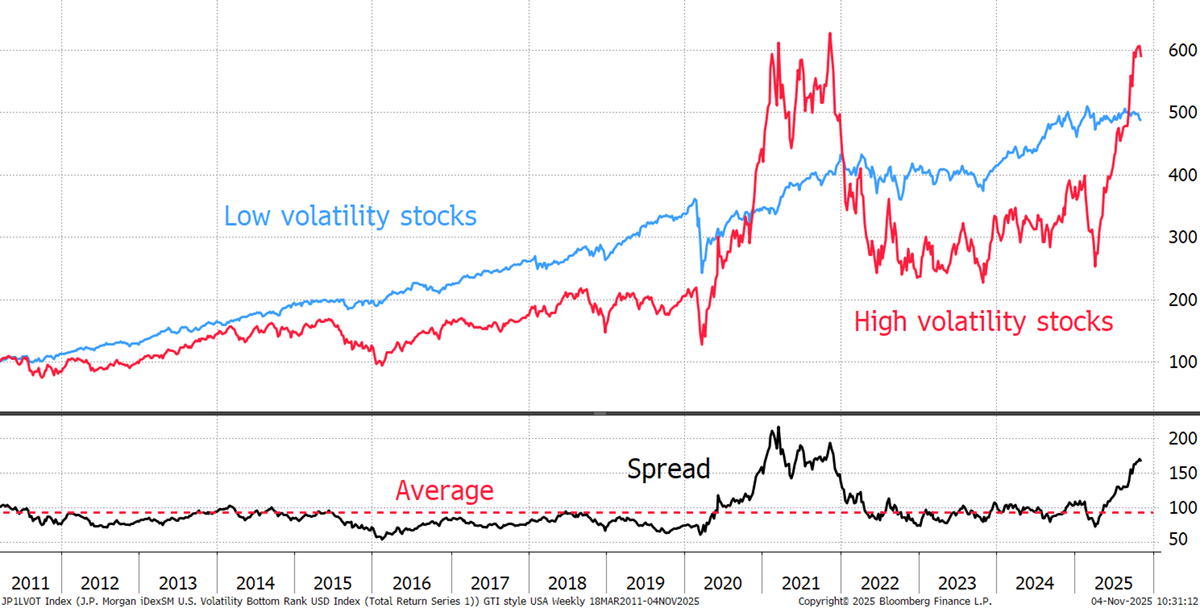Boring Is Beautiful
Trade in the Whisky Portfolio;
In yesterday’s Global Trends (GTI) note “Alpha Extremes”, I showed how the concentration of market leadership is getting truly ridiculous while most of the stockmarket was acting somewhat normally, whatever ‘normally’ means for stockmarkets. Please read that GTI note for more details, but I can sum it up with one chart.
NASDAQ Share of the S&P 500 Market Cap

The last great technology bubble in 2000 saw the NASDAQ 100 Index, comprised of the tech stocks of their day, such as Microsoft, Cisco, Intel, etc., reach 30% of the US market capitalisation. We thought that was punchy back then. Today’s team, namely NVIDIA, Apple, Microsoft, etc., has reached 55% of the US cap. I was brought up believing that the largest stocks rarely turn out to be good investments, except during major bubbles. There can be no doubt that this is a major bubble.
The boring stocks are underrated, as they often are. I have shown this chart before, on several occasions, and I’m calling time. This move in 2025, which took off following the Tariff Crash in April, has been led by speculative stocks. I sense their exhaustion, and the smart move is to go the other way. If that’s not enough, the dollar is rising again. Market risk just jumped a notch.
Speculative Versus Defensive Stocks

General - Your capital is at risk when you invest, never risk more than you can afford to lose. Past performance and forecasts are not reliable indicators of future results. Bid/offer spreads, commissions, fees and other charges can reduce returns from investments. There is no guarantee dividends will be paid. Overseas shares - Some recommendations may be denominated in a currency other than sterling. The return from these may increase or decrease as a result of currency fluctuations. Any dividends will be taxed at source in the country of issue.
Funds - Fund performance relies on the performance of the underlying investments, and there is counterparty default risk which could result in a loss not represented by the underlying investment. Exchange Traded Funds (ETFs) with derivative exposure (leveraged or inverted ETFs) are highly speculative and are not suitable for risk-averse investors.
Bonds - Investing in bonds carries interest rate risk. A bondholder has committed to receiving a fixed rate of return for a fixed period. If the market interest rate rises from the date of the bond's purchase, the bond's price will fall. There is also the risk that the bond issuer could default on their obligations to pay interest as scheduled, or to repay capital at the maturity of the bond.
Taxation - Profits from investments, and any profits from converting cryptocurrency back into fiat currency is subject to capital gains tax. Tax treatment depends on individual circumstances and may be subject to change.
Investment Director: Charlie Morris. Editors or contributors may have an interest in recommendations. Information and opinions expressed do not necessarily reflect the views of other editors/contributors of ByteTree Group Ltd. ByteTree Asset Management (FRN 933150) is an Appointed Representative of Strata Global Ltd (FRN 563834), which is regulated by the Financial Conduct Authority.
© 2025 ByteTree Group Ltd






